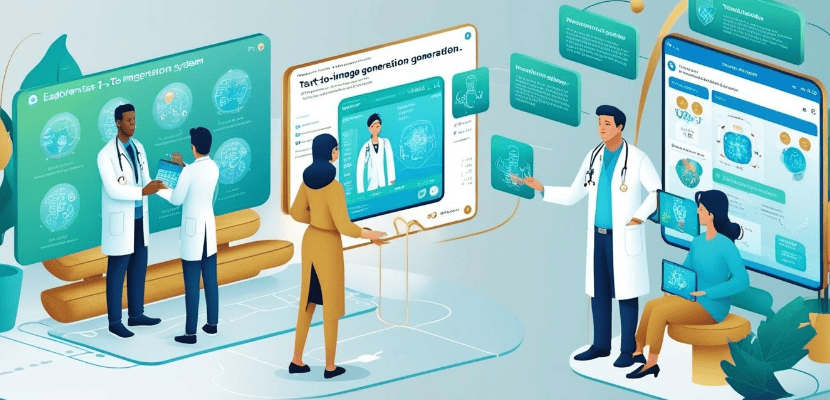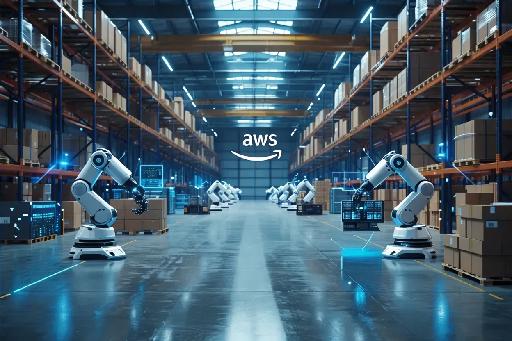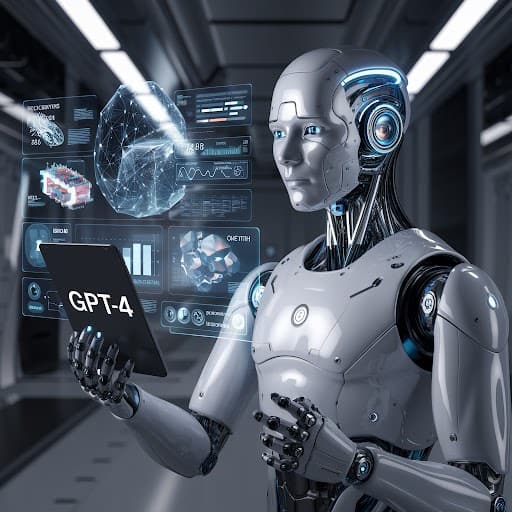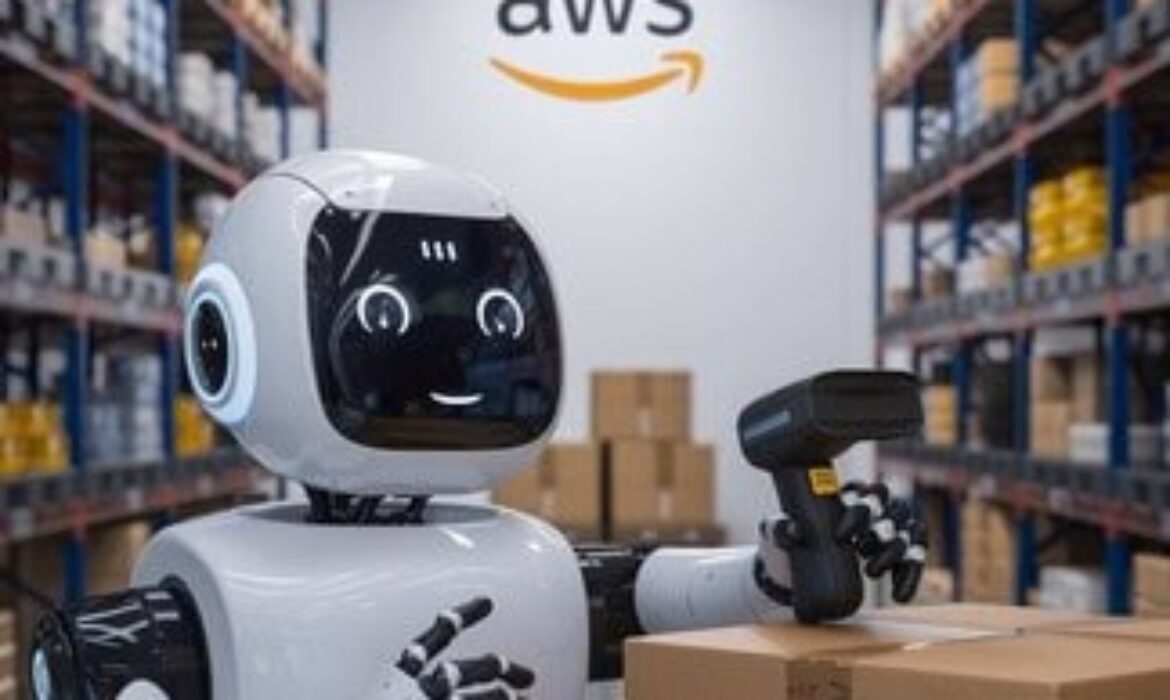Transforming Healthcare Management: Overcoming Challenges with AI Solutions
History of Healthcare Management
Healthcare management has historically grappled with numerous challenges, such as rising costs and administrative inefficiencies. For example, before the introduction of AI, hospitals often relied on cumbersome paper-based systems for patient records, which were prone to errors. A nurse might accidentally misread a patient’s handwritten chart, potentially leading to incorrect medication administration. These outdated practices not only delayed care but also strained healthcare professionals, ultimately compromising patient outcomes and increasing operational burdens.
The introduction of AI is revolutionizing healthcare management by enabling accurate data analysis and streamlining administrative tasks. For instance, AI-driven tools like chatbots can handle patient inquiries, schedule appointments, and provide medical information, significantly reducing the workload on administrative staff. Additionally, AI algorithms can analyze patient data to predict health risks, allowing providers to offer proactive care. This not only improves decision-making and enhances patient care but also fosters a more responsive healthcare system, ultimately leading to better experiences for both patients and providers.
AI’s Impact on Healthcare Administrative Processes
AI is transforming healthcare administration by optimizing processes like appointment scheduling. Platforms such as Zocdoc use AI to match patients with providers based on availability and preferences, reducing double bookings and no-shows. This approach streamlines scheduling and allows healthcare staff to focus on delivering quality care.
In billing and claims processing, AI platforms like Olive AI automate repetitive tasks, from extracting billing information to verifying codes. This reduces errors and speeds up payment processes, benefiting both healthcare providers and patients. By automating these tasks, AI allows staff to dedicate more time to patient-focused activities.
Key Challenges in Healthcare Management AI
Inconsistent Data Quality
AI systems require accurate and high-quality data, but many healthcare organizations struggle with inconsistent or fragmented information across various systems. For example, when a hospital’s electronic health record (EHR) system does not integrate with its lab results system, critical data may be missing, leading to inaccurate diagnoses or treatment recommendations.
Fragmented Systems
Interoperability, or the ability of different systems to communicate and exchange data seamlessly, is a significant challenge for healthcare organizations. Disparate software solutions may hinder coordinated care; for instance, a patient’s medical history recorded at one hospital might not be accessible to another using a different platform, complicating AI’s ability to provide comprehensive insights.
Navigating Regulatory Landscapes
Healthcare is a heavily regulated field, and integrating AI technologies must comply with strict guidelines regarding patient data privacy and security, such as those outlined by HIPAA in the United States. This regulatory complexity can impede the adoption of AI, as organizations may risk legal penalties if they do not adhere to these requirements.
Cultural Resistance to Innovation
Introducing AI technologies can meet resistance from healthcare professionals who are used to traditional methods. Many may fear job displacement or question the reliability of AI systems. For example, radiologists may hesitate to adopt AI diagnostic tools due to concerns about their expertise being undermined. Overcoming this resistance necessitates effective training and demonstrating AI’s ability to enhance human decision-making.
Improving Patient Care Through AI Innovations
AI innovations are transforming patient care by enhancing diagnosis, treatment, and personal engagement. Intelligent algorithms analyze vast amounts of healthcare data—including medical histories, imaging, and genomics—to identify patterns and predict patient outcomes, enabling earlier and more accurate diagnoses. For instance, AI-powered diagnostic tools can assist medical professionals in detecting diseases at earlier stages, improving treatment efficacy. Additionally, AI-driven chatbots and virtual health assistants provide patients with immediate access to information and support, enhancing engagement and adherence to treatment plans.
Moreover, predictive analytics in AI can help healthcare providers anticipate potential complications, leading to timely interventions that improve patient safety. AI can also optimize resource allocation within hospitals, streamlining operations to improve patient throughput and reduce wait times. Overall, the integration of AI into healthcare systems fosters a more personalized, proactive approach to patient care, ultimately resulting in better health outcomes.
Data Security and Privacy in AI-Driven Systems
Data security and privacy are paramount in AI-driven systems, particularly in healthcare, where sensitive patient information is involved. Ensuring that AI applications comply with strict regulations, such as HIPAA, is essential to protect personal health data from breaches and misuse. Implementing robust encryption, access controls, and continuous monitoring helps safeguard data integrity. Additionally, organizations must address ethical concerns regarding data usage, ensuring transparency and patient consent in AI systems, thereby fostering trust and compliance while enhancing the effectiveness of AI technologies.
Text-to-Image Generation in Healthcare: Exploring Its Impact
The Rise of AI in Healthcare: A New Era of Visualization
Integrating artificial intelligence in healthcare advances the visualization and interpretation of complex medical data. Traditionally, professionals relied on static imaging techniques like X-rays and MRIs, which required skilled interpretation. With AI-powered technologies, however, vast datasets can be analyzed rapidly to produce dynamic visual representations, enhancing understanding and decision-making. This shift is particularly impactful for diagnosing complex conditions, where AI can reveal patterns that may be difficult to discern through conventional methods.
AI-driven visualization is also crucial in personalizing patient care. By synthesizing data from electronic health records, lab results, and genetic information, AI generates comprehensive visual models of a patient’s health, enabling clinicians to assess risks and tailor treatment plans more effectively. For example, text-to-image generation systems can convert clinical descriptions into detailed visuals, providing clearer insights into patient anatomy and pathology. As this technology advances, AI’s role in transforming healthcare visualization will lead to improved health outcomes and more informed decision-making.
Additionally, AI visualization fosters collaboration among interdisciplinary healthcare teams. Radiologists, surgeons, and specialists can share interactive visualizations, enhancing communication and improving outcomes during complex cases. As demand for efficient, patient-centered care increases, AI’s ability to bridge information gaps positions it as a vital force in reshaping healthcare delivery. This convergence of advanced visualization tools and AI technology promises innovations that streamline operations while elevating the quality of care patients receive.
How Text-to-Image Generation Works: Behind the Technology
Text-to-image generation leverages advanced artificial intelligence techniques, primarily using deep learning algorithms such as generative adversarial networks (GANs) and transformer models. In this process, GANs consist of a generator and a discriminator: the generator creates images from text prompts, while the discriminator evaluates their authenticity. Through iterative training, the generator improves the quality and relevance of its outputs, transforming abstract concepts into visually compelling representations. This dynamic interaction enables the creation of images that can range from realistic to artistic, based on the input description.
These systems utilize extensive datasets that pair text and images, allowing models to learn complex associations between language and visuals. When a user provides a descriptive prompt, the model generates an image that encapsulates the essence of the description, considering context and details. Such capabilities can significantly enhance diagnostics, patient education, and treatment planning in healthcare. For example, clinicians could generate visual representations of medical conditions based on written descriptions, improving understanding and communication. As technology continues to evolve, integrating text-to-image generation into clinical workflows holds great promise for enhancing visualization tools in healthcare.
Open-Source Platforms Advancing Medical Imaging Innovations
Open-source platforms are pivotal in advancing medical imaging innovations, providing researchers with collaborative tools that enhance diagnostic capabilities. By granting access to source code, these platforms promote shared knowledge and rapid development, allowing teams to refine algorithms and imaging techniques. Popular platforms like 3D Slicer and ITK-SNAP enable customization for specific clinical needs, driving real-world innovation. The transparency of open-source software fosters trust and security, which are essential in healthcare. Consequently, these platforms accelerate technological advancements and deliver adaptable solutions in medical imaging.
The impact of open-source platforms is significant across medical imaging applications, from diagnostics to treatment planning. They support the development of sophisticated algorithms for image analysis, improving the accuracy of identifying abnormalities. Machine learning integration further enhances predictive analytics, aiding personalized treatment strategies. Additionally, these tools facilitate real-time collaboration among clinicians, essential for multidisciplinary care. As adoption grows, the potential for standardization in imaging practices increases, ultimately benefiting patient outcomes. This synergy between open-source innovation and healthcare is shaping the future of medical imaging.
Patient Engagement: Visual Tools for Better Understanding
Visual tools are essential in improving patient engagement by making complex medical information easier to understand. Diagrams, infographics, and interactive models help healthcare providers communicate diagnoses and treatment options effectively. By simplifying medical jargon, these aids empower patients to actively participate in their care decisions. This increased understanding leads to better adherence to treatment plans and enhanced health outcomes. Additionally, visual tools encourage collaboration between patients and providers, fostering open dialogue and trust.
These tools also accelerate medical discoveries by improving communication among researchers and clinicians. Visual representations of complex data help streamline the analysis and interpretation of clinical findings. Collaborative platforms utilizing visualization techniques can enhance research workflows and innovation in treatment development. Moreover, when patient-generated data is visualized, it offers valuable insights into treatment effectiveness. As visual tools advance, their impact on patient engagement and medical discoveries will continue to grow.
Future Trends: What’s Next for Text-to-Image Systems in Healthcare
The future of text-to-image technology in healthcare holds transformative potential, revolutionizing diagnostics, patient education, and medical training. With ongoing advancements in machine learning, these systems are increasingly capable of generating high-quality, contextually accurate images from detailed textual descriptions. This progress empowers healthcare professionals to visualize complex medical scenarios with greater precision. For instance, surgeons may soon create visual representations of anatomical structures based on surgical notes, enhancing preoperative planning and potentially improving surgical outcomes. Furthermore, integrating text-to-image systems with electronic health records (EHRs) could enable the automatic generation of educational materials specific to patient conditions, leading to improved understanding, engagement, and adherence to medical guidance.
In medical research and training, text-to-image systems promise impactful applications. Researchers can use them to produce illustrative images that convey study findings, making complex data more accessible to colleagues and the public. For medical trainees, the ability to visualize rare conditions or intricate cases will foster a deeper understanding and greater familiarity with diverse clinical presentations. As collaboration between developers, healthcare providers, and regulatory bodies strengthens, ethical frameworks will safeguard patient privacy while maximizing the utility of these tools. Altogether, text-to-image systems are poised to advance both patient care and medical education, bridging gaps in understanding and contributing to better healthcare outcomes.
AI-Enhanced Data Integration Solutions for AWS Supply Chain
AI Streamlines Data Integration in AWS Supply Chains
AI streamlines data integration in AWS supply chains by automating and optimizing data processing from various sources, such as suppliers, inventory systems, and logistics platforms. Leveraging AWS services like Amazon S3 for data storage and Amazon Kinesis for real-time data streaming, AI algorithms efficiently analyze, categorize, and clean vast datasets. AI-powered tools like Amazon SageMaker enable machine learning models to predict demand, track inventory, and optimize logistics, reducing human error and improving decision-making.
With AI, supply chain data is processed faster and more accurately, allowing businesses to respond to market fluctuations and customer needs in real time. AWS IoT services also integrate with AI to manage and monitor IoT devices across the supply chain, providing real-time visibility into operations. By automating data integration and leveraging predictive analytics, AI and AWS enable supply chains to be more responsive, agile, and efficient in today’s competitive landscape.
Real-Time Data Processing in Supply Chains
Real-time data processing in supply chains allows companies to instantly collect and analyze data from various sources, such as IoT devices and logistics systems. This enables quick adjustments and decision-making to improve operations, optimize inventory, and manage delivery schedules. By leveraging cloud platforms like AWS, businesses can continuously monitor supply chain activities and respond immediately to disruptions or changes.
The process works through IoT sensors embedded in vehicles or equipment, transmitting data to cloud services like AWS Lambda or Amazon Kinesis. AI and machine learning algorithms then analyze this data in real-time, allowing companies to detect potential issues and make proactive adjustments. This combination of real-time insights and rapid decision-making leads to greater efficiency, reduced delays, and enhanced overall performance.
Predictive Analytics in AWS Supply Chain Management
Predictive analytics in AWS supply chain management harnesses AI to forecast future outcomes from historical and real-time data. By analyzing data from inventory systems and customer demand, AI models can anticipate demand fluctuations, optimize inventory levels, and pinpoint potential disruptions in the supply chain.
With AWS services like Amazon SageMaker, businesses can create and deploy machine learning models that efficiently process large datasets. These models facilitate proactive decision-making, enabling companies to identify challenges in advance and make informed adjustments to enhance efficiency and reduce costs. By integrating AI-driven predictive analytics, organizations gain crucial insights into supply chain trends, leading to more accurate demand planning, improved resource allocation, and a more agile, resilient supply chain.

Challenges and AI Solutions in Supply Chain Management
Global Economic Uncertainty: Economic fluctuations, geopolitical tensions, and inflation create challenges for supply chains by causing unpredictable demand and rising costs. However, AI improves predictive analytics, enabling companies to forecast demand accurately and anticipate cost increases. This proactive strategy allows businesses to adapt quickly, maintain operational efficiency, and navigate market uncertainties with greater resilience.
Technological Integration: While integrating technologies like AI, IoT, and blockchain can be complex and costly, AI simplifies the process by providing smarter interfaces and automating data management. It reduces the burden of data collection and processing, allowing companies to focus on meaningful analysis. AI also eases employee resistance to change by improving system usability, making the adoption of new technologies smoother and more efficient.
Inventory Management Issues: AI significantly improves inventory management by enhancing demand forecasting through predictive analytics. It helps prevent stockouts and overstocking by analyzing data and market trends. AI-driven tools also recommend optimal stock levels based on real-time conditions, ensuring efficient and adaptive inventory management.
Cybersecurity Threats: As logistics systems digitize, the risk of cyber-attacks increases, posing ongoing challenges for data protection and operational security. AI enhances cybersecurity by deploying advanced threat detection systems that analyze network traffic and detect patterns indicating potential attacks. Additionally, AI automates incident response, improving security protocols and ensuring more efficient, comprehensive protection.
Supply Chain Disruptions: Natural disasters, pandemics, and political instability can disrupt supply chains, with COVID-19 revealing critical vulnerabilities. AI enhances risk assessment and management by predicting disruptions through real-time data analysis. Machine learning algorithms identify patterns signaling potential issues, allowing companies to take proactive measures and develop contingency plans, ultimately strengthening supply chain resilience.
Future Trends: The Evolving Landscape of AI in Supply Chains
AI can significantly enhance logistics and supply chain management related to goods and services by addressing common challenges. For instance, AI-driven predictive analytics can improve demand forecasting for various products and services amid global economic uncertainties, while automation technologies can alleviate labor shortages by handling repetitive tasks in warehouses and distribution centers, thus boosting overall efficiency. Additionally, AI can optimize transportation routes for the delivery of goods, reducing rising costs through efficient logistics planning.
In terms of supply chain disruptions affecting goods and services, AI enhances risk management by predicting potential issues through real-time data analysis, allowing companies to develop proactive contingency plans. Meanwhile, AI can elevate customer experiences by providing real-time tracking of deliveries, automating customer inquiries with chatbots, and personalizing services according to consumer preferences.
Furthermore, AI helps with regulatory compliance by monitoring changes affecting the transport of goods and services and identifying potential issues, while optimizing operations for sustainability through energy-efficient routing and waste reduction in packaging and distribution. In inventory management, AI-driven analytics allow for better demand forecasting, helping businesses navigate stock levels for both goods and services effectively. Overall, AI technologies streamline operations and improve resilience in logistics, addressing contemporary challenges effectively.
Empowering Retail Growth with Scalable Cloud Infrastructure
Consumer demands are rapidly changing, forcing retailers to adapt their supply chain, inventory management, and customer engagement strategies to remain competitive. As expectations shift, the importance of cloud infrastructure in driving retail growth becomes more pronounced. Cloud technology offers the scalability and agility needed to address fluctuating customer demands, particularly during peak seasons and promotional events. By leveraging cloud solutions, retailers can optimize operations and enhance the overall customer experience. This adaptability is essential for sustainable growth in a dynamic retail landscape.
In today’s digital-first environment, consumers expect convenience, personalization, and seamless experiences across both online and physical channels. Cloud infrastructure helps retailers meet these demands by centralizing data and streamlining processes by utilizing data analytics, artificial intelligence, and machine learning and gains valuable insights into consumer behavior and preferences. This knowledge allows for refined marketing strategies and optimized inventory management. Embracing cloud technology enables retailers to navigate the evolving retail sector with agility and efficiency, positioning them for long-term success.
Role of Cloud Infrastructure in Retail Transformation
Cloud infrastructure is transforming the retail industry by offering unparalleled scalability, especially during peak shopping seasons. Thanks to the elasticity of cloud computing, retailers can dynamically adjust computing resources to handle spikes in web traffic and transactions effortlessly. With features like cloud-based load balancing and content delivery networks (CDNs), retailers can optimize performance and minimize latency during high-demand periods. Additionally, autoscaling capabilities allow retailers to automatically scale resources, ensuring seamless operations during peak times and enhancing the customer experience.
Moreover, cloud infrastructure provides robust data management solutions essential for modern retail. Retailers can securely store and analyze vast amounts of customer data, sales transactions, and inventory details, gaining key insights into consumer behavior, preferences, and market trends. This data-driven approach enables personalized marketing strategies and optimized product offerings, driving customer loyalty and business growth. By leveraging cloud-based data management, retailers can run targeted campaigns, predict demand, and improve the customer experience across multiple channels, strengthening their competitive edge in the retail market.
Meeting Growing Retail Demands Seamlessly
Scalable cloud solutions are essential for retailers to manage fluctuating customer demands, especially during peak seasons. With cloud infrastructure, retailers can dynamically adjust their operations to handle varying levels of demand, ensuring consistent performance and high customer satisfaction during high-traffic periods. Cloud-based load balancing and content delivery networks (CDNs) allow retailers to efficiently manage web traffic, reduce latency, and enhance the shopping experience.
Additionally, cloud technology empowers retailers to leverage advanced data management and analytics for informed decision-making based on market trends and consumer behavior. By securely storing and analyzing large volumes of customer data, retailers can refine marketing strategies, predict demand, and optimize product offerings to align with changing customer preferences. Cloud-based solutions seamlessly integrate big data and analytics, enabling targeted campaigns and enhancing the customer experience across multiple channels, demonstrating the agility and customer-centric approach necessary to meet the evolving demands of the retail industry.

Maximizing Retail Efficiency with Cloud Infrastructure
Heightened data security: Cloud infrastructure provides robust data security measures, including encryption, access controls, and regular backups, safeguarding sensitive customer information and business data from potential threats.
Enhanced user experience: By leveraging cloud technology, retailers can deliver seamless and personalized experiences across multiple touchpoints, ensuring a cohesive and responsive interaction with customers, and ultimately fostering brand loyalty.
Improved inventory management: Cloud-based inventory systems enable real-time tracking, demand forecasting, and automated replenishment, optimizing stock levels, reducing holding costs, and minimizing stockouts, thereby improving operational efficiency.
Effective disaster management: Cloud infrastructure offers data redundancy, off-site backups, and disaster recovery capabilities, ensuring minimal disruptions and swift recovery in the event of unforeseen incidents such as system failures or natural disasters.
Increased profitability: The agility and scalability of cloud solutions support cost-efficient operations, enabling retailers to respond swiftly to market demands, reduce infrastructure costs, and allocate resources effectively, ultimately contributing to increased profitability and sustainability.
Cloud Shapes Future Retail Growth Landscape
In the future, cloud technology is set to revolutionize retail, driving efficiency and personalized experiences. Retailers will increasingly rely on cloud-based solutions for real-time data analytics and operational agility across digital and physical channels. The integration of AI, machine learning, and IoT with cloud computing will enhance engagement and enable retailers to adapt to changing market dynamics.
Cloud technology’s future in retail growth also promises improved resilience and adaptability, empowering retailers to swiftly respond to market shifts and disruptions. This flexibility will enable retailers to thrive in a competitive digital landscape by enhancing operational agility and driving growth through data-driven strategies.
Leveraging Generative AI for Healthcare Insights: A Guide for SMEs
Revolutionizing Healthcare SMEs with Generative AI
Generative AI is transforming the healthcare landscape for Small and Medium-sized Enterprises (SMEs) by facilitating the effective utilization of expansive datasets. This advanced technology empowers SMEs to extract valuable insights from their healthcare data, improving operational efficiency and more informed decision-making. By leveraging Generative AI, SMEs can optimize patient care through more accurate diagnoses, personalized treatment plans, and streamlined administrative processes, ultimately enhancing patient outcomes and resource management.
Furthermore, Generative AI enables healthcare SMEs to stay competitive in the dynamic healthcare industry by offering tailored, cost-effective solutions that drive advancements in healthcare delivery and operational effectiveness. With this technology, SMEs can navigate the complexities of modern healthcare, unlocking new opportunities for growth, efficiency, and improved healthcare delivery while effectively managing resources and staying at the forefront of innovation in the sector.
Turning Data into Actionable Health Insights with AI
AI is a game-changer in healthcare as it allows professionals to uncover intricate patterns and correlations within vast datasets for better diagnostics and personalized care. Its predictive analytics capabilities enable accurate projections of patient outcomes and personalized preventive interventions, enhancing chronic disease management and refining treatment strategies.
Moreover, AI serves as an asset in augmenting clinical decision support, offering evidence-based treatment recommendations and real-time alerts that streamline care pathways. Its effectiveness extends to image analysis, particularly in radiology, pathology, and dermatology, where deep-learning models swiftly interpret medical images for diagnostics. AI’s natural language processing capabilities contribute to improved documentation and research analysis. Additionally, AI-driven applications enhance patient engagement and remote monitoring, empowering individuals to manage chronic conditions and enabling crucial early intervention practices for optimal health outcomes.
AI and Analytics: Improving Patient Care Operations
AI and analytics are revolutionizing patient care by enabling personalized and efficient delivery using data. Through AI-driven predictive analytics, healthcare organizations can anticipate and address potential health issues proactively, improving outcomes and resource allocation. This shift to preventive care reduces readmissions and boosts long-term health management, offering tailored treatments for greater patient satisfaction and improved health results. AI identifies hidden data patterns for precise diagnoses and early intervention, enhancing overall care quality.
Moreover, AI streamlines healthcare operations by automating administrative tasks, accelerating diagnoses, and enhancing treatment plans. This automation improves accuracy, patient experiences, and reduces errors, freeing up time for healthcare professionals to focus on patient care efficiently. AI optimizes resource allocation, ensuring cost-effective and sustainable care delivery, and fostering a high-quality and cost-efficient healthcare environment for patients and providers.
Affordable AI Implementation Strategies for SMEs
1. Utilize Cloud Services: Leveraging cloud-based AI platforms allows SMEs to access advanced AI capabilities without the need for significant upfront investments in hardware or infrastructure. They can benefit from pay-as-you-go models, scaling resources based on their needs while avoiding costly infrastructure setups.
2. Open-Source AI Tools: Utilizing open-source AI tools and libraries can significantly reduce software licensing costs for SMEs. These tools provide a cost-effective way to implement AI solutions, as the development and customization can be done in-house or with the help of the online community.
3. Partner with AI Service Providers: Collaborating with AI service providers or consulting firms specializing in affordable AI solutions can offer SMEs access to expertise in developing and deploying AI applications within budget constraints. These partners can help tailor AI solutions to meet specific business needs while keeping costs in check.
4. Scalable AI Platforms: Embracing scalable AI platforms, such as machine learning as a service (MLaaS), allows SMEs to pay only for the AI resources and services they use. This flexibility enables them to optimize cost-efficiency by avoiding unnecessary expenses on underutilized AI resources.
According to a recent report, 72% of executives believe that despite the growing potential of generative AI, only 5% of businesses have successfully developed and implemented generative AI projects. This highlights a significant gap between the technology’s capabilities and its adoption in the corporate world. Many companies are still in the early stages of exploring how to integrate AI into their operations, missing out on its transformative benefits. However, executives recognize the immense potential generative AI holds to revolutionize industries, suggesting that a wider implementation shortly could drastically improve innovation and efficiency across sectors.
Role of AWS Select Partners: Healthcare AI
An AWS Select Partner can provide valuable assistance to small and medium-sized enterprises looking to leverage generative AI for healthcare insights in several ways:
1. Technology Expertise: They can offer expertise in implementing AWS services specifically tailored for generative AI applications in healthcare. This includes selecting the right AWS tools, such as Amazon SageMaker, to build, train, and deploy machine learning models for healthcare data analysis.
2. Custom Solutions: AWS Select Partners can help SMEs develop custom generative AI solutions tailored to their healthcare data and insights needs. This could involve creating algorithms that generate insights from medical imaging data, patient records, or clinical trial data.
3. Compliance and Security: Partners can guide SMEs in ensuring that their generative AI solutions meet healthcare industry standards and compliance requirements, such as HIPAA, and help implement best practices for securing and protecting sensitive healthcare data on AWS.
4. Training and Support: Partners can provide training and support to SMEs, helping them understand how to use generative AI models effectively to derive valuable healthcare insights and integrate these models into their existing workflows.
5. Cost Optimization: They can assist SMEs in optimizing their AWS usage and costs for generative AI solutions, ensuring that the infrastructure is scalable and cost-efficient while delivering the required healthcare insights.
By offering expertise, tailored solutions, compliance guidance, and ongoing support, an AWS Select Partner can play a critical role in helping SMEs successfully leverage generative AI for healthcare insights.
From Data to Insight: GPT Models Transform Machine Learning
GPT Models: Methods and Considerations
Training GPT models involves a meticulous process that ensures the model can generate meaningful and coherent text. The process begins with pre-training, where the model is exposed to vast datasets to learn the structure, grammar, and context of language. During this stage, the model identifies patterns and relationships between words, phrases, and sentences. Once pre-trained, the model can generate general text, but to make it more useful for specific tasks, fine-tuning is essential. Fine-tuning involves adjusting the model on a smaller, task-specific dataset, which allows it to learn particular nuances related to the use case. This step improves the model’s performance on tasks like question answering, text summarization, or sentiment analysis.
Another key aspect of GPT model training is transfer learning, where knowledge gained from the pre-trained model is applied to new tasks. By leveraging a pre-trained base, transfer learning reduces the need for large datasets and shortens the time required to train a model from scratch. This method enables GPT models to quickly adapt to domain-specific challenges, providing customized and accurate results with less computational effort. Considerations like managing overfitting and ensuring data diversity are vital to maintaining a model’s generalization capabilities, making fine-tuning and transfer learning both critical steps in the effective deployment of GPT models.
Insights Extraction: How GPT Models Analyze Data
GPT models are powerful tools that utilize advanced natural language processing techniques to effectively analyze both structured and unstructured data. Their ability to detect patterns and relationships within structured data, often found in databases and spreadsheets, allows GPT models to excel in tasks such as data summarization and predictive analysis. Organizations can harness these capabilities to extract valuable insights from large datasets, facilitating improved decision-making grounded in historical trends. Additionally, when dealing with unstructured data—such as text, images, and multimedia—GPT models showcase their proficiency in processing vast amounts of information. They can identify significant themes, sentiments, and anomalies, transforming raw data into actionable insights that enhance customer experiences and deepen understanding of market dynamics across various industries.
The adaptability of GPT models spans several sectors, including finance, healthcare, and marketing, enabling organizations to derive critical insights for informed decision-making. In the financial sector, these models can assess market sentiment and predict economic trends, while in healthcare, they improve patient care by extracting insights from feedback and medical literature. In marketing, GPT models empower brands to understand consumer behavior through the analysis of unstructured data, enabling more targeted campaigns and enhanced customer engagement. As indispensable tools for organizations aiming to fully leverage their data, GPT models are pivotal in driving strategic, data-informed decisions by extracting meaningful insights from a wide range of data sources.

Improving Decisions Using GPT-Powered Analytics
Utilizing GPT-powered analytics for decision-making taps into the advanced capabilities of the Generative Pre-trained Transformer (GPT) model to uncover valuable insights from a variety of datasets. GPT is particularly effective in analyzing unstructured data, such as text and images, by identifying complex patterns and trends. This enhances the decision-making process by automating tasks like data analysis and natural language processing, allowing organizations to extract actionable intelligence from intricate data sources.
Ensuring the accuracy of GPT-powered analytics requires continuous refinement, including fine-tuning model parameters, ongoing training, and validating outputs. This process helps maintain relevance and reliability. Fostering a data-driven decision-making culture is equally important, as it enables organizations to fully leverage GPT’s potential. By integrating cutting-edge technology and sophisticated analytics, companies across sectors like finance, healthcare, and marketing can make more informed, strategic decisions.
Impact on Startups, SMEs, and Large Enterprises
Exploring various avenues within this technology, many startups often begin by utilizing natural language understanding and generation capabilities to decipher the structure and significance of unstructured data. This serves as a popular starting point, given its applicability across a range of solutions and use cases. For fledgling companies embracing innovation, integrating generative AI models throughout an application can rapidly spark creativity, establish a competitive advantage, and introduce novel engagement strategies.
For SMEs, collaboration with service providers that utilize GPT models can optimize marketing strategies through sentiment analysis tools, enabling insights into customer feedback for tailored messaging and product offerings. Automation of tasks like content generation and document summarization can boost productivity and streamline operations for SMEs. Similarly, large enterprises can benefit from implementing GPT models to extract profound insights from vast amounts of unstructured data, enhancing decision-making processes and refining strategies in response to market dynamics and customer preferences. Ultimately, the incorporation of GPT models empowers businesses of all sizes to leverage AI-driven solutions for growth and competitiveness in today’s evolving business landscape.
Challenges and Considerations in Deploying GPT Models
Deploying GPT models presents challenges such as model bias, interpretability, and scalability. Mitigating model bias requires a thorough assessment of training data to eliminate biases and ensure equitable decision-making. Additionally, ensuring the interpretability of GPT models is crucial for building user trust, accomplished through techniques like attention mapping and model explanation frameworks. Addressing these challenges demands a concerted effort to prioritize diverse and unbiased training data and invest in interpretability-enhancing tools.
Scalability represents another key consideration, necessitating robust infrastructure and efficient resource allocation to handle the computational demands of deploying GPT models at scale. By proactively addressing these challenges, organizations can ensure that GPT deployments uphold fairness, transparency, and performance in real-world applications.
GPT Models Shaping Machine Learning Trends
The future trends of machine learning are closely intertwined with the evolving role of GPT models. As cutting-edge advancements continue to refine GPT models’ natural language processing capabilities, they are poised to play a pivotal role in driving the next wave of innovation in machine learning. These trends are expected to see GPT models further pushing the boundaries of language understanding and generation, enabling more nuanced and contextually accurate outputs.
Moreover, as GPT models become increasingly sophisticated, their impact on advancing machine learning applications across various industries is anticipated to be transformative. By spearheading advancements in natural language processing, GPT models are set to revolutionize how AI systems process, analyze, and generate human language, paving the way for more intelligent and adaptable machine learning solutions that have far-reaching implications for the future.
AI-Powered Banking: Innovations in Financial Services
Artificial intelligence is revolutionizing the banking sector with personalized financial solutions and enhanced fraud detection capabilities. This transformation not only enriches customer experiences but also fortifies security through predictive analytics and machine learning. By optimizing processes, enhancing risk management, and fostering product innovation, AI drives efficiency by automating routine tasks. This enables bank personnel to concentrate on strategic initiatives while gaining deeper insights into customer behaviors. Overall, AI’s integration streamlines operations, tailors services, and facilitates informed decision-making, laying the foundation for growth and operational excellence in financial services.
AI and Security: Safeguarding Financial Transactions
It is at the forefront of fortifying the integrity of financial transactions. Through advanced algorithms, Generative AI plays a pivotal role in proactively detecting and preventing fraudulent activities, bolstering security measures, and instilling trust in the banking system. Furthermore, it effectively manages risk by leveraging predictive analytics to assess and mitigate potential threats, ultimately contributing to the improvement of credit scoring systems and risk management processes.
Moreover, Generative AI provides personalized financial advice based on individual customer behaviors and preferences, offering tailored recommendations that enhance decision-making and financial well-being. By seamlessly integrating advanced AI capabilities, financial institutions can ensure the protection and optimization of transactions, empowering both customers and the financial sector as a whole.
Automation Revolutionizing Banking Operations
Automation is revolutionizing banking operations by streamlining processes such as customer onboarding, loan approvals, and compliance checks. Technologies like RPA and AI reduce processing times and errors, freeing up resources for innovation and strategic initiatives while improving service quality. Additionally, automation enhances the customer experience through 24/7 AI-driven chatbots and virtual assistants, offering faster responses and personalized service to a broader customer base.
Moreover, automation aids banks in maintaining regulatory compliance by efficiently handling complex checks and audits, reducing the risk of compliance violations. It also mitigates financial and reputational risks, ensuring regulatory adherence and sustainable growth in a competitive market.

Challenges and Limitations of Using AI in Financial Institutions
Enhancing Data Security and Privacy
Financial institutions encounter significant cybersecurity risks due to the substantial volume of customer data they manage. To counter these threats, institutions must implement robust cybersecurity measures such as encryption and access controls. The integration of AI-driven security solutions bolsters the ability to identify and respond to potential threats. Moreover, fostering a culture of compliance and providing employee training prioritizes data protection, ultimately strengthening the institution’s overall security posture.
Mitigating Algorithmic Bias
AI systems relying on historical data are susceptible to perpetuating bias, which can result in unfair lending practices and skewed risk assessments. To address this, regular audits of data and algorithms are essential to identify and rectify biases. Leveraging diverse datasets and employing explainable AI techniques contribute to fostering transparency in the decision-making processes, ensuring fair and equitable outcomes.
Navigating Regulatory Compliance
The intricate landscape of regulatory requirements demands that financial institutions establish dedicated compliance teams. Collaborating with regulators to comprehend and adapt to evolving compliance requirements is crucial. Additionally, the adoption of automated compliance tools facilitates ongoing adherence to regulations, thereby ensuring that the institution operates within the parameters of varying regulatory environments.
The Future of AI in Banking and Its Advantages
The future of AI in banking holds immense potential for transformation, offering numerous advantages to financial institutions.
1. Enhanced Customer Experience: AI-powered chatbots and virtual assistants deliver personalized service, enabling banks to address customer inquiries swiftly, improving overall satisfaction.
2. Advanced Fraud Detection: AI algorithms analyze transaction patterns in real-time to identify anomalies, enhancing security and minimizing losses from fraud.
3. Improved Risk Management: Predictive analytics provide more accurate assessments of creditworthiness, leading to better risk management and informed lending decisions.
4. Operational Efficiency: Automation of routine tasks, like data entry and compliance reporting, streamlines operations, reducing costs and allowing staff to focus on strategic initiatives.
5. Data-Driven Decision Making: AI analyzes vast data sets, offering insights that drive strategic decisions and helping banks identify market trends.
6. Personalized Financial Products: AI tailors financial offerings to individual customer needs, boosting retention and satisfaction.
Overall, AI is set to revolutionize banking by enhancing security, efficiency, and customer engagement, ensuring sustained growth in a competitive landscape.
Smart Search: AI Engines Redefining Digital Discovery
AI-powered search engines have intensified information retrieval, marking a significant advancement in user experience. Traditional search engines relied on basic algorithms and keyword matching, struggling to keep up with the growing complexity and volume of digital content. The introduction of AI-driven platforms ushered in a new era of search by utilizing machine learning and natural language processing (NLP) to grasp user intent, resulting in personalized search results and greater contextual relevance. Perplexity AI, Bing, YEP, and You.com are among the platforms leveraging these technologies to enhance search capabilities, with Perplexity AI excelling in interpreting complex queries and Bing offering personalized, conversational experiences.
This transformation in search technology not only reshapes how users access information but also revolutionizes their engagement with digital platforms. AI-powered engines now deliver more intuitive and personalized outcomes, tailored to individual behaviors and preferences. As AI progresses, these platforms are set to play a more significant role in providing precise, context-aware, and ethical digital experiences. This evolution suggests a future where search engines comprehend user intent better, paving the way for a personalized and responsible digital environment.
The Evolution from Traditional to AI-Powered Search
The shift from traditional to AI-powered search engines has revolutionized how we access digital information. Early search engines relied on basic algorithms and keyword matching, which often produced inaccurate results due to their inability to grasp deeper context or user intent. In contrast, AI-powered search engines utilize machine learning and natural language processing (NLP) to interpret context, semantics, and user behavior, providing more accurate and personalized search experiences.
AI’s integration has significantly enhanced search engine capabilities, enabling a better understanding of user intent and more tailored results. This evolution sets a new standard for accuracy and relevance while ushering in the future of predictive, conversational, and voice-activated searches, ultimately transforming the user experience and redefining the digital search landscape.
NLP Enhances Searches; Machine Learning Boosts Precision
The utilization of Natural Language Processing (NLP) is instrumental in enhancing search functionality as it enables search engines to effectively comprehend and interpret user queries. Through the processing of intricate language structures, NLP facilitates the delivery of more precise and contextually pertinent search results, ultimately enriching the user experience by fostering intuitive and conversational interactions that bridge the gap between human language and machine understanding.
Simultaneously, machine learning algorithms play a pivotal role in further enhancing search precision by continuously assimilating insights from user interactions and behaviors. By scrutinizing extensive datasets to identify patterns and trends, these algorithms empower search engines to optimize results in alignment with individual preferences and intent. The combined prowess of NLP and machine learning engenders a formidable synergy that elevates search capabilities, yielding highly personalized outcomes and reshaping the dynamics of user access and engagement with online information. This evolution paves the way for a new standard of accuracy and relevance within the digital search landscape.
Understanding User Intent: How AI Personalizes Search Results
In the domain of AI-driven search engines, the ability to discern user intent is crucial for delivering personalized search results. Through meticulous analysis of keywords, contextual hints, and user behavior, AI algorithms can accurately grasp the true purpose behind each search query. By employing advanced techniques in natural language processing (NLP) and machine learning, these algorithms can predict user preferences and tailor search results accordingly, ensuring relevance and elevating user satisfaction.
By continuously learning from user interactions, AI not only hones its understanding of intent but also anticipates future needs, offering a more intuitive and tailored browsing experience. This proactive approach not only simplifies information retrieval but also promotes deeper user engagement by presenting content that closely matches individual preferences and browsing habits. As AI progresses, its ability to interpret and cater to user intent is poised to revolutionize how people interact with and consume digital information.
The Role of AI in Voice and Visual Search
Voice and visual search are advanced search technologies that allow users to find information through spoken commands or images, rather than traditional text-based queries. Voice search uses speech recognition to interpret and respond to voice queries, making it easier for users to interact with search engines hands-free. Visual search enables users to upload or capture images, allowing AI to analyze and identify objects, text, or scenes within the image for relevant search results.
AI plays a vital role in both technologies. In voice search, AI uses NLP to understand context and intent, delivering accurate and relevant responses. For visual search, AI leverages machine learning and computer vision to recognize patterns, objects, and features in images. This helps users explore information more intuitively, enhancing personalization and improving overall search accuracy and efficiency.
The Future of Search: What’s Next for AI-Powered Engines?
The future looks promising for AI-powered search engines, with continuous developments in natural language processing, machine learning, and predictive analytics driving them towards predictive and personalized search interactions. By enhancing their ability to understand user intent, context, and preferences, AI-driven search engines are poised to deliver highly tailored results, heralding a new era focused on precision and relevance in search experiences.
Anticipated improvements in voice-activated searches and conversational interfaces are expected to revolutionize user experiences, facilitating more fluid and intuitive interactions with search platforms. This shift towards user-friendly interfaces foresees a future where individuals can engage with search engines in a natural, conversational manner, fundamentally altering the landscape of information retrieval. Furthermore, a spotlight on AI ethics and transparency will be essential to address bias and ensure responsible AI practices, paving the way for search engines that offer personalized, accurate, and ethically sound digital experiences.
Legacy Chatbot vs AI Chatbot: Which is the Better Choice?
Legacy chatbots are built on older technology, using rule-based systems that rely on predefined scripts and keywords to handle interactions. They work well for basic queries but struggle with more complex conversations, often limiting customer engagement and satisfaction. Legacy chatbots include scripted responses, heavy reliance on keyword recognition, and basic functionality for tasks like answering FAQs. They also lack learning capabilities, meaning they don’t improve with each interaction, which can lead to repetitive and limited responses.
AI chatbots have revolutionized the chatbot landscape by using natural language processing (NLP), machine learning, and advanced algorithms. They offer more personalized and meaningful interactions, adapting to user needs and providing efficient responses. AI chatbots include understanding natural language for human-like conversations, learning from past interactions to improve, maintaining context during exchanges, and handling diverse tasks such as customer support and sales inquiries.
AI Innovations: Enhancing Customer Service & Productivity
Enhancing Customer Experience with AI-Powered Virtual Agents and Voice Assistants
Customer service virtual agents and voice assistants leverage generative AI to revolutionize customer interactions. These innovative technologies offer intuitive conversational interfaces that enhance human capabilities and cater to diverse business needs.
Boosting Enterprise Productivity through AI-Powered Solutions
By incorporating generative AI-powered chatbots, enterprises can standardize internal communications and empower employees with self-service options for common inquiries. Moreover, these solutions improve conversation flows for tech support and streamline routine activities, ultimately reducing human error rates.
Benefits of AI Chatbots
- Conversational AI: AI chatbots use advanced NLP to engage in human-like interactions, making customers feel like they are talking to a real person. This personalized experience fosters meaningful interactions, addressing customer concerns with accuracy and empathy.
2. Empowering Self-Service: AI chatbots provide intelligent self-service options that efficiently handle a wide range of inquiries, streamlining the support process and saving time for customers. This enhances convenience and overall satisfaction, reducing the burden on human agents and improving the customer journey.
3. Cost-Effective Support: AI chatbots automate repetitive tasks, like answering common questions, reducing the need for human agents and resulting in substantial cost savings for businesses. Additionally, they provide 24/7 customer support, ensuring service availability without incurring the costs of constant staffing.
User Experience with AI Chatbots
AI chatbots excel in providing a smooth and pleasant user experience by adeptly comprehending natural language, retaining context, and customizing interactions. Through the analysis of user data, they can customize responses, suggestions, and deals according to individual preferences, elevating the degree of personalization. Moreover, AI chatbots offer constant support, guaranteeing that customers can receive help at any time, in contrast to human agents. Furthermore, they enhance efficiency by managing numerous inquiries concurrently, cutting down on wait times and notably increasing response rates, ultimately streamlining and enhancing the overall customer experience.
Choosing the Right Chatbot for Business
When it comes to selecting a chatbot for business, the choice between legacy and AI chatbots hinges on the specific needs, objectives, and budget. Each option has its strengths and weaknesses, so it’s important to weigh various factors before making a decision. Below are some key considerations that can guide choosing the right chatbot solution:
1. Business Objectives
Understanding business goals is critical for selecting the most suitable type of chatbot. For companies with short-term objectives, such as quickly managing simple customer inquiries, answering frequently asked questions, or guiding users through basic processes, a legacy chatbot may suffice. These chatbots can efficiently handle straightforward tasks without the need for complex technology. However, for businesses focused on long-term growth and improving customer engagement, investing in an AI chatbot is a more advantageous option.
AI chatbots provide enhanced features, including personalized responses and contextual understanding, which facilitate deeper customer relationships and lead to greater satisfaction. This makes AI chatbots valuable for businesses aiming to scale their operations and enhance overall customer experience.
2. Customer Expectations
Customer expectations play a crucial role in choosing the right chatbot. If the customer base prefers quick, straightforward responses with minimal interaction, a legacy chatbot may be ideal for handling basic queries efficiently. However, if a more personalized and engaging experience is expected, AI chatbots are the better option, as they can understand natural language, adapt to individual preferences, and provide dynamic interactions that enhance customer satisfaction.
3. Budget Constraints
Legacy chatbots tend to have lower initial costs, which can be attractive for businesses with tight budgets, but they may require more maintenance over time, increasing overall expenses. AI chatbots, while requiring a higher upfront investment, offer significant long-term savings by managing a greater volume of inquiries, boosting efficiency, and improving customer satisfaction, ultimately delivering a stronger return on investment.
4. Technical Infrastructure
Assessing the current technical setup is vital for maintaining smooth operations. It’s important to determine how effectively a chatbot can integrate with existing systems like customer relationship management (CRM) software and other business tools. AI chatbots are typically built for compatibility with modern platforms, enabling seamless integration with various applications, which improves overall operational performance.
5. Scalability Requirements
Anticipating growth or an increase in customer inquiries makes opting for an AI chatbot a wise decision. These chatbots are designed to scale, allowing them to adapt to changing demands and handle more complex queries as the business expands. This scalability ensures that customer service capabilities grow in tandem with the business, facilitating the maintenance of high-quality service levels.
In a nutshell, AI chatbots have many benefits when comparing legacy chatbots and AI chatbots. They are more capable, provide a better user experience, and can easily adapt to different situations. While legacy chatbots can be useful for specific tasks, their limitations can lead to unhappy customers, especially in today’s fast-paced digital world.
As companies focus more on keeping customers engaged and running their operations smoothly, AI chatbots are becoming the preferred option. By recognizing the differences between the two chatbot types and aligning the choice with business objectives, organizations can make the best selection for their needs. Ultimately, investing in an AI chatbot can enhance customer interactions, support business growth, and help succeed in the digital age.
Overcoming Telecom Management Challenges with Generative AI
The Telecommunications Management Network (TMN) is an architectural framework designed to manage network resources effectively through predefined interfaces, now enhanced by AI technologies. This hierarchical approach allows for efficient modeling of network resources and management entities, addressing various aspects of telecommunications, from operations to service and business management, while leveraging AI to optimize performance and streamline communication.
TMN’s architecture consists of several key layers. The element management layer utilizes AI for monitoring lower-level resources like switching systems, enhancing performance management, and metrics tracking. The network management layer employs AI to analyze data for improved connection management and resource grouping. In the service management layer, AI enhances service logic, ensuring efficient resource utilization. Finally, the business management layer integrates AI to optimize stakeholder relationships and oversee service deployment from a commercial perspective.
AI Integration for Enhanced Customer Service in Telecom
In the rapidly evolving telecommunications sector, leveraging AI in customer service has become essential for staying competitive. As customer expectations rise, telecom companies must deliver prompt support to ensure loyalty. AI-driven solutions like chatbots, virtual assistants, and automated communication services enable round-the-clock inquiry management, significantly cutting wait times and providing immediate assistance, thereby elevating the overall customer experience.
AI’s capability to analyze customer interactions reveals valuable insights into behavior patterns. This understanding allows telecom providers to customize their services effectively, proactively addressing issues and minimizing churn while fostering stronger customer loyalty.
Ultimately, integrating AI not only enhances operational efficiency but also equips telecom companies to swiftly respond to market changes. By delivering personalized service tailored to individual preferences, telecom providers can deepen customer relationships and achieve long-term success in telecommunications management.
Minimizing Downtime: Predictive Maintenance with AI
Minimizing downtime in telecom operations is critical, and predictive maintenance powered by AI offers a robust solution. By analyzing real-time data from network equipment and infrastructure, AI can predict potential failures before they occur. This proactive approach enables telecom companies to schedule maintenance precisely when needed, rather than relying on reactive measures that can lead to unexpected outages.
Additionally, predictive maintenance enhances asset management by optimizing resource allocation. AI algorithms can identify patterns and trends that human operators might overlook, allowing for timely interventions that extend the life of critical infrastructure. By reducing the frequency and duration of equipment failures, telecom providers not only maintain seamless service for their customers but also significantly cut maintenance costs.
Ultimately, integrating AI for predictive maintenance empowers telecom companies to transform their operational strategies. This shift not only minimizes downtime but also boosts overall efficiency, leading to improved customer satisfaction and loyalty. By embracing this technology, firms can ensure their networks remain resilient against the demands of an increasingly digital world.
AI-Enhanced Resource Management in TMN
AI-enhanced resource management in the Telecommunications Management Network (TMN) is vital for optimizing complex telecom infrastructures. By leveraging AI technologies, operators can analyze real-time data, facilitating better decision-making and resource allocation. This proactive management minimizes downtime and enhances service reliability, allowing telecom companies to respond swiftly to potential issues and optimize network performance effectively.
In the broader scope, this integration significantly boosts customer satisfaction. Improved network performance and reduced service interruptions create a seamless experience for users, which is crucial in today’s competitive market. AI-driven insights enable telecom operators to adapt to fluctuating demands and ensure efficient service delivery, ultimately strengthening customer loyalty.
Moreover, AI-enhanced resource management fosters organizational agility, equipping telecom companies to embrace emerging technologies like 5G and IoT. This adaptability not only streamlines day-to-day operations but also positions operators for future growth. By integrating AI within TMN, telecom providers become more resilient and responsive, ready to tackle evolving industry challenges and capitalize on new opportunities.
AI for Streamlined Data Management and Traffic Forecasting
AI is crucial for streamlined data management and traffic forecasting in the telecommunications industry due to the exponential growth of data and the complexity of network operations. As networks expand and user demands increase, telecom operators face challenges in efficiently managing vast amounts of data while ensuring optimal performance. AI-driven analytics tools can process and analyze this data in real-time, allowing operators to make informed decisions quickly. By leveraging machine learning algorithms, AI can identify patterns in traffic usage and predict future demand, enabling proactive adjustments to network resources.
Moreover, accurate traffic forecasting is essential for maintaining service quality and customer satisfaction. AI can enhance forecasting models by incorporating various factors such as historical usage data, time-of-day trends, and external influences like events or weather conditions. This predictive capability allows telecom operators to allocate resources effectively, minimizing congestion and ensuring smooth service delivery.
Ultimately, the integration of AI in data management and traffic forecasting not only improves operational efficiency but also enhances the overall user experience. By anticipating user needs and optimizing network performance, telecom providers can maintain a competitive edge in a rapidly evolving market, ensuring reliable connectivity for their customers.
The Transformative Impact of Generative AI in Telecom
GenAI is revolutionizing the telecom industry as networks grow more complex with the implementation of 5G and IoT. Efficiently managing these networks is increasingly challenging, but GenAI addresses this by automating tasks, optimizing performance, and enhancing the customer experience. By predicting network traffic patterns, telecom providers can proactively allocate resources, effectively reducing congestion and downtime while improving overall operational efficiency.
In addition to network management, GenAI is significantly enhancing customer support. AI-powered chatbots and virtual assistants enable telecom companies to handle inquiries more efficiently, offering real-time assistance that eases the burden on human agents. This not only boosts customer satisfaction but also streamlines support processes. As GenAI continues to drive innovation, it will facilitate personalized services, bolster security measures, and enable seamless network management, positioning telecom companies at the forefront of technological advancements. The influence of GenAI in the telecom sector is profound and essential for future competitiveness.



















